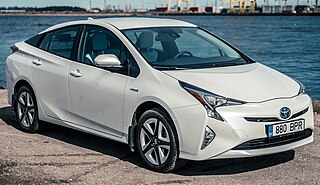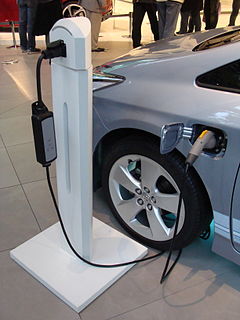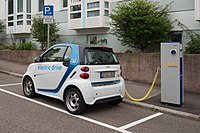Related Research Articles

A hybrid vehicle is one that uses two or more distinct types of power, such as submarines that use diesel when surfaced and batteries when submerged. Other means to store energy include pressurized fluid in hydraulic hybrids.

An electric vehicle (EV) is a vehicle that uses one or more electric motors for propulsion. It can be powered by a collector system, with electricity from extravehicular sources, or it can be powered autonomously by a battery. EVs include, but are not limited to, road and rail vehicles, surface and underwater vessels, electric aircraft and electric spacecraft.

The Toyota Prius is a car built by Toyota which has a hybrid drivetrain, combining an internal combustion engine with an electric motor. Initially offered as a four-door sedan, it has been produced only as a five-door liftback since 2003.

Practical electric vehicles appeared during the 1890s. An electric vehicle held the vehicular land speed record until around 1900. In the 20th century, the high cost, low top speed, and short-range of battery electric vehicles, compared to internal combustion engine vehicles, led to a worldwide decline in their use as private motor vehicles. Electric vehicles have continued to be used for loading and freight equipment and for public transport – especially rail vehicles.

The Mitsubishi Outlander is a compact crossover SUV manufactured by Japanese automaker Mitsubishi Motors. It was originally known as the Mitsubishi Airtrek when it was introduced in Japan in 2001.

A plug-in hybrid electric vehicle (PHEV) is a hybrid electric vehicle whose battery pack can be recharged by plugging a charging cable into an external electric power source, in addition to internally by its on-board internal combustion engine-powered generator. Most PHEVs are passenger cars, but there are also PHEV versions of commercial vehicles and vans, utility trucks, buses, trains, motorcycles, mopeds, and even military vehicles.

The Honda Clarity is a nameplate used by Honda on alternative fuel vehicles. It was initially used only on hydrogen fuel-cell electric vehicles such as the 2008 Honda FCX Clarity, but in 2017 the nameplate was expanded to include the battery-electric Honda Clarity Electric and the plug-in hybrid electric Honda Clarity Plug-in Hybrid, in addition to the next generation Honda Clarity Fuel Cell. Clarity production ended in August 2021 with US leases for the fuel cell variant continuing through to 2022.

The Chevrolet Volt is a plug-in hybrid manufactured by General Motors, also marketed in rebadged variants as the Holden Volt in Australia and New Zealand and the Buick Velite 5 in China, and with a different fascia as the Vauxhall Ampera in the United Kingdom and as the Opel Ampera in the remainder of Europe. Volt production ended in February 2019.

A charging station, also known as a charge point or electric vehicle supply equipment (EVSE), is a piece of equipment that supplies electrical power for charging plug-in electric vehicles.

The history of plug-in hybrid electric vehicles (PHEVs) spans a little more than a century, but most of the significant commercial developments have taken place after 2002. The revival of interest in this automotive technology together with all-electric cars is due to advances in battery and power management technologies, and concerns about increasingly volatile oil prices and supply disruption, and also the need to reduce greenhouse gas emissions. Between 2003 and 2010 most PHEVs on the roads were conversions of production hybrid electric vehicles, and the most prominent PHEVs were aftermarket conversions of 2004 or later Toyota Prius, which have had plug-in charging and more lead-acid batteries added and their electric-only range extended.

An electric car, battery electric car, or all-electric car is an automobile that is propelled by one or more electric motors, using only energy stored in batteries. Compared to internal combustion engine (ICE) vehicles, electric cars are quieter, have no exhaust emissions, and lower emissions overall. In the United States and the European Union, as of 2020, the total cost of ownership of recent electric vehicles is cheaper than that of equivalent ICE cars, due to lower fueling and maintenance costs. Charging an electric car can be done at a variety of charging stations; these charging stations can be installed in both houses and public areas.

The adoption of plug-in electric vehicles in the United States is supported by the American federal government, and several states and local governments. As of December 2021, cumulative sales in the U.S. totaled 2.32 million highway legal plug-in electric cars since 2010, led by all-electric cars. The American stock represented 20% of the global plug-in car fleet in use by the end of 2019, and the U.S. had the world's third largest stock of plug-in passenger cars after China (47%) and Europe (25%).

The Toyota Prius Plug-in Hybrid is a plug-in hybrid liftback manufactured by Toyota. The first-generation model was produced from 2012 to 2016. The second-generation model has been produced since 2016.

Electric car use by country varies worldwide, as the adoption of plug-in electric vehicles is affected by consumer demand, market prices, availability of charging infrastructure, and government policies, such as purchase incentives and long term regulatory signals.

Government incentives for plug-in electric vehicles have been established around the world to support policy-driven adoption of plug-in electric vehicles. These incentives mainly take the form of purchase rebates, tax exemptions and tax credits, and additional perks that range from access to bus lanes to waivers on fees. The amount of the financial incentives may depend on vehicle battery size or all-electric range. Often hybrid electric vehicles are included. Some countries extend the benefits to fuel cell vehicles, and electric vehicle conversions.

The adoption of plug-in electric vehicles in the United Kingdom is actively supported by the British government through the plug-in car and van grants schemes and other incentives. About 745,000 light-duty plug-in electric vehicles had been registered in the UK up until December 2021, consisting of 395,000 all-electric vehicles and 350,000 plug-in hybrids. Until 2019, the UK had the second largest European stock of light-duty plug-in vehicles in use after Norway.

The stock of plug-in electric passenger cars in Canada in use totaled 141,060 units at the end of 2019, consisting of 78,680 all-electric cars and 62,380 plug-in hybrids. Sales totaled 50,960 units in 2019.

The Hyundai Ioniq is a compact five-door liftback manufactured and marketed by Hyundai. The nameplate Ioniq is a portmanteau of ion and unique. It is marketed as the first automobile to be offered without a standard internal combustion engine, but rather sold in hybrid, plug-in hybrid, and all-electric variants.
As of June 2021, there were around 800 electric vehicles registered in Manitoba. As of 2021, about 0.8% of all new vehicles registered in Manitoba were electric.
As of September 2021, there were 10 battery electric vehicles and 12 plug-in hybrid vehicles registered in the Northwest Territories.
References
- ↑ "Drive Electric NL awarded $295K grant to open electric vehicle resource centre". CBC News. February 14, 2022. Retrieved April 22, 2022.
- ↑ "$10 child care, a break on car registration and other ways N.L.'s budget will affect your wallet". CBC News. April 7, 2022. Retrieved April 22, 2022.
- ↑ Wall, Lukas (August 30, 2021). "Completion of 1st fast-charging network 'just the beginning' for electric car owners in N.L." Retrieved April 22, 2022.
- ↑ Roberts, Darrell (March 31, 2022). "Voisey's Bay nickel could end up in electric vehicles from companies like BMW and Tesla under new deals". CBC News. Retrieved April 22, 2022.
- ↑ Kennedy, David (August 22, 2022). "EVs present a 'generational opportunity' in Canadian mining industry". Automotive News Canada. Archived from the original on August 23, 2022. Retrieved September 19, 2022.
- ↑ "Mining deals between Canada and German automakers could benefit N.L.'s industry, says executive". CBC News. August 28, 2022. Retrieved September 19, 2022.
- ↑ Lagerquist, Jeff (September 19, 2022). "Electric vehicle batteries could add $48B annually to Canada's economy: report". Yahoo! Finance. Retrieved September 19, 2022.
Ontario, Quebec, Alberta, and Newfoundland and Labrador have each introduced critical mineral strategies that emphasize EV battery minerals.

